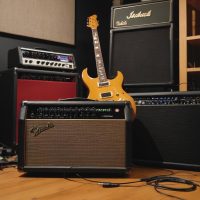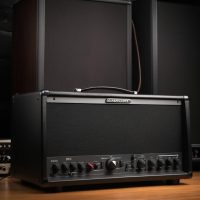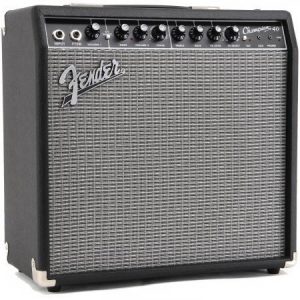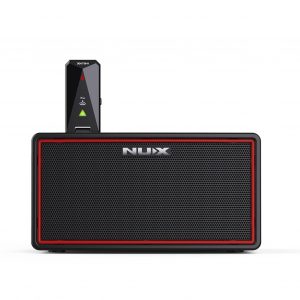Fender 65 Princeton Reverb
$999.99
Experience the iconic Fender 65 Princeton Reverb guitar amp, renowned for its legendary classic tones and powerful sound, perfect for any style of music.
Compare
Description
Are you looking for a guitar amp that combines vintage tone with modern features and reliability? Look no further than the Fender 65 Princeton Reverb, a legendary amplifier that has been a favorite of guitarists for decades.
The Fender 65 Princeton Reverb is based on the classic Princeton Reverb of the mid-1960s, which was a compact yet powerful amp that became popular among studio musicians, small clubs, and home players. The new version of the amp keeps the original’s iconic tone, but adds some upgrades that make it even more versatile and user-friendly.
One of the best things about the Fender 65 Princeton Reverb is its sound. This amp delivers the warm and organic tone that Fender is famous for, thanks to its all-tube circuitry, 10-inch speaker, and spring reverb tank. Whether you are playing clean or dirty, loud or soft, the Princeton Reverb delivers a dynamic and expressive tone that responds to your playing style and guitar.
But the Fender 65 Princeton Reverb is not just a one-trick pony. This amp has some modern features that make it more convenient and flexible than the original Princeton Reverb. For example, it has a channel-switching footswitch that lets you toggle between the Normal and Vibrato channels, each with its own volume and tone controls. You can also adjust the reverb level and tone to your liking, or use the effects loop to connect external pedals.
Another advantage of the Fender 65 Princeton Reverb is its portability. This amp is small and lightweight enough to carry around without breaking your back or your budget. It has a sturdy and stylish cabinet that comes in different finishes, such as blackface, silverface, or limited editions with special colors or speakers. Whether you are rehearsing, recording, or gigging, the Princeton Reverb can fit in any space and sound great.
To sum up, the Fender 65 Princeton Reverb is a classic guitar amp that combines vintage tone with modern convenience. This amp has stood the test of time and remains a favorite of many guitarists, from country to rock to blues to jazz. If you want to experience the magic of Fender, try the Princeton Reverb and hear the difference it makes. Happy playing!
Fender 65 Princeton Reverb properties
| Product name |
65 Princeton Reverb |
| Brand |
Fender |
| Type |
Guitar Amplifiers |
| Sound Effects |
Reverb, Tremolo |
| Sound Setting |
Bass, Treble, Volume |
| Elements Size Bass |
10.0 “ |
| Elements Amount Bass |
1 |
| Power Output (RMS) |
12.0 W |
| Amplifier Model |
Hybrid Combo |
| Colour |
Black |
| Impedance |
8 |
| Height |
406.0 mm |
| Depth |
241.3 mm |
| Width |
505.0 mm |
| Weight |
15.4 kg |
Frequently Asked Questions:
What unique features differentiate the circuit design of a Fender 65 Princeton Reverb amplifier from other models in its series?
The Fender 65 Princeton Reverb amplifier is distinguished from other models in its series by several unique circuit design features. Firstly, it introduces the reverberation effect, which creates a spacious and immersive sound by reflecting the original signal multiple times before mixing it back with the input. This feature is not present in the earlier Princeton Chorus amplifier or the standard Princeton amps. Secondly, the 65 Princeton Reverb amplifier has a modified preamp section that adds brightness and clarity to the sound, making it more versatile for different genres of music. Lastly, the power output of this model is rated at 12 watts, which is higher than the 8-watt output of the Princeton Chorus and standard Princeton amplifiers, providing a slightly louder and punchier sound. These features make the Fender 65 Princeton Reverb amplifier a popular choice among guitarists for its unique tonal capabilities and versatility in different playing styles.
How does the tube-driven Fender 65 Princeton Reverb amplifier differ from solid-state models in terms of tone and versatility?
The tube-driven Fender 65 Princeton Reverb amplifier differs from solid-state models in several ways when it comes to tone and versatility. Here are a few key differences:
1. Warmth and depth: Tube amps like the Fender 65 Princeton Reverb have a unique warmth and depth that solid-state amps struggle to replicate. This is due to the way tubes distort and saturate as they're pushed harder, creating rich harmonics and overtones. The result is a more complex and organic sound that can be especially compelling in genres like blues, jazz, and country. Dynamic response: Another key difference is that tube amps have a more dynamic and responsive feel than solid-state models. This is because tubes are sensitive to the subtlest nuances of your playing style, allowing you to coax a wider range of tones and expressions out of your guitar. This can make all the difference in terms of expressiveness and musicality. Versatility: While some solid-state amps are designed for specific genres or styles (such as metal or clean jazz), tube amps like the Fender 65 Princeton Reverb offer a much wider range of tonal possibilities. This is due to the versatility of tubes, which can be pushed in a variety of ways to produce everything from smooth, silky cleans to screaming distortion and beyond. Maintenance: Finally, it's worth mentioning that tube amps require more maintenance than solid-state models, as tubes need to be replaced periodically due to aging or failure. However, many guitarists feel that the added effort is well worth it in terms of tone and responsiveness. And with proper care and attention, tubes can last for years, providing a rich, rewarding sound that's hard to beat.
How does the unique preamp design and custom-designed Celestion speaker of the Fender 65 Princeton Reverb contribute to its distinct tone and versatility in different musical genres?
The Fender 65 Princeton Reverb's unique preamp design and custom-designed Celestion speaker contribute significantly to its distinctive tone and versatility across various musical genres. The preamp circuitry is based on the classic Fender blackface design, which provides a warm, rich sound with plenty of midrange punch. This allows the Princeton Reverb to deliver a balanced and articulate tonality that's well-suited for a range of styles, from clean and clear jazz and blues to more aggressive rock and roll. The custom Celestion speaker further enhances the amplifier's versatility by providing a smooth and detailed response across the frequency spectrum. This speaker is designed specifically for use in Fender amps, ensuring that it complements the Princeton Reverb's unique tonal characteristics. The result is an amplifier that can deliver everything from crisp and bright lead tones to warm and full-bodied rhythm sounds, making it a versatile choice for musicians of all styles and genres. Additionally, the Fender 65 Princeton Reverb's reverb and tremolo effects contribute to its overall tonal character, adding depth and dimension to your sound. The reverb effect is particularly noteworthy, as it provides a rich and natural-sounding decay that can add texture and space to your playing. Together with the preamp design and Celestion speaker, these features make the Fender 65 Princeton Reverb an ideal choice for musicians looking for a versatile and high-quality amplifier that's well-suited for a range of musical styles.
How does the tube-driven tremolo circuit in the Fender 65 Princeton Reverb differ from traditional tremolo effects, and what factors contribute to its unique tonal character?
The Fender 65 Princeton Reverb amp features a tube-driven tremolo effect that differs from traditional tremolo effects in several ways. Traditional tremolos typically use an electronic oscillator to create a variable waveform that is then mixed with the incoming signal. This results in a predictable and consistent effect, but it can lack the natural warmth and harmonic content of an analog circuit. In contrast, the tube-driven tremolo in the Fender 65 Princeton Reverb uses two 12AX7 tubes to create a variable waveform that is then mixed with the incoming signal. This approach creates a more organic and harmonically rich effect, as the tubes naturally distort and saturate the signal. Additionally, the tube-driven tremolo in the Fender 65 Princeton Reverb allows for greater depth and dynamic range than traditional effects. The tremolo depth control on the amp allows you to adjust the amount of modulation, while the rate control determines how quickly the effect cycles. These controls interact with each other in a non-linear way, resulting in a rich and complex effect that is highly responsive to playing dynamics. Another factor that contributes to the unique tonal character of the tube-driven tremolo in the Fender 65 Princeton Reverb is the amp's overall tone circuitry. The amp uses a preamp section consisting of four 12AX7 tubes, followed by a power amp section with two EL84 tubes. This configuration results in a warm and responsive sound that complements the tube tremolo effect, providing a cohesive and harmonically rich tonal signature. Overall, the tube-driven tremolo effect in the Fender 65 Princeton Reverb offers a unique and highly versatile modulation option that is both organic and dynamic. Its non-linear control interactions and harmonic richness make it an essential feature for musicians who demand the highest level of tonal performance from their amplifiers.
Before you buy Fender 65 Princeton Reverb










Gospodark –
After 15 years, I returned to my 25-year-old guitar and chose the Fender amplifier despite being a fan of Marshall products. The amplifier sounds great. It has great sound capabilities and many, many effects that can be further edited for individual settings. After the purchase, I found that I am selling my effects in the form of cubes because I do not need them. In the Region, I could describe the amplifier in superlatives, so I will present the disadvantages because there are fewer:
– connection to a computer with a mini USB – standard, unusual for the current times,
– the manual is laconic and no description of the function, you need to work on the amplifier a bit before we can figure out what’s what, although I haven’t worked out the connection with the flashing diode yet.
– Could use a clearance for a clean channel. You have to twist a bit to get the sound without effects – although you can set the settings to the desired position and the problem disappears.
Apart from the provisions of nuances, because I would not call them disadvantages – I rate the amplifier very high for home and garage.